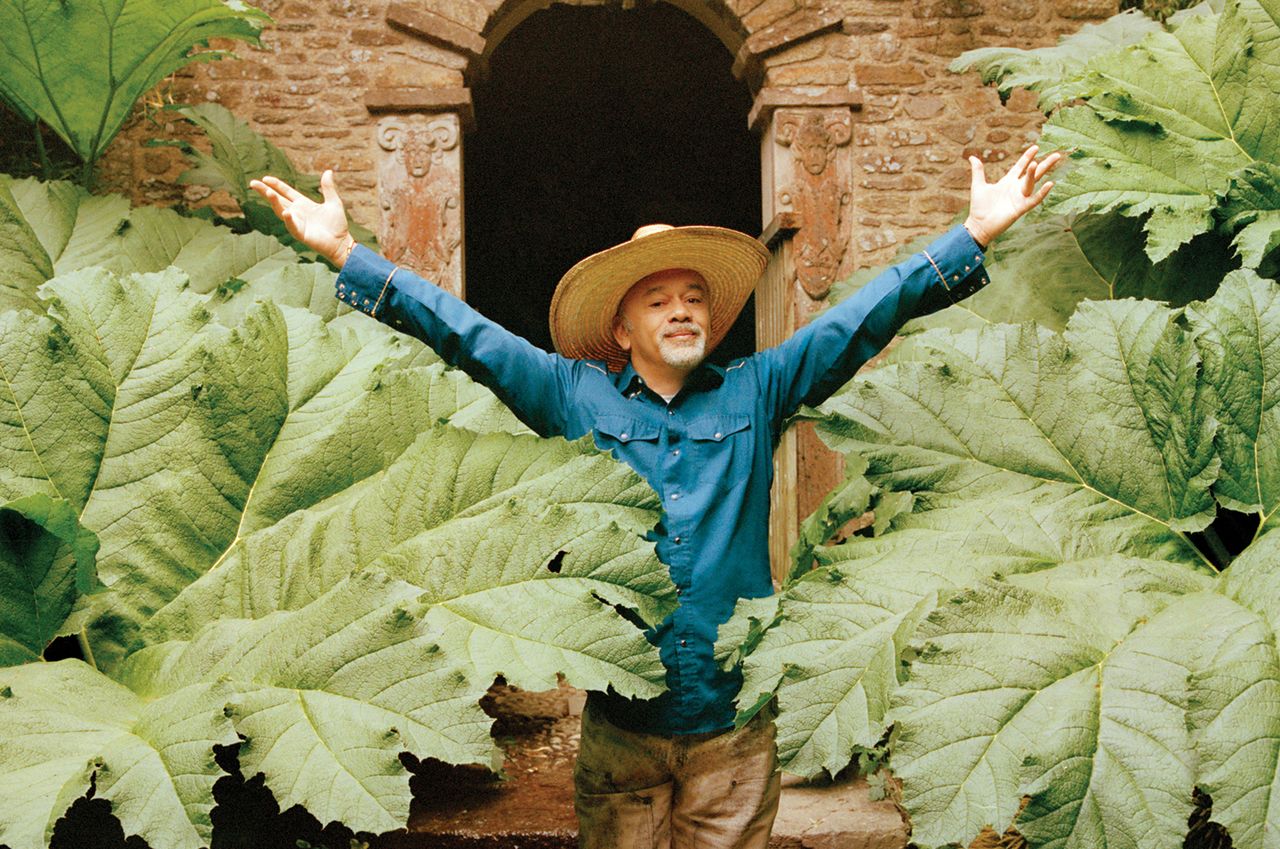Before Christian Louboutin rose to international fame as a designer of witty stilettos with high-gloss red soles for Prince, Beyoncé and Sex and the City femme fatale Carrie Bradshaw—and later Taylor Swift, Zendaya and Iggy Azalea—a chance encounter with a garden in Brittany nearly set his life on a wildly different trajectory.
In his mid 20s, Louboutin, already a decade into his career, was feeling burned out. He wondered to himself whether, after dressing the dancers of the Folies Bergère, apprenticing to footwear eminence Roger Vivier and freelancing for Chanel, he’d peaked as a shoemaker. While working as a designer-for-hire, he’d also been helping friends tend their small Paris plots. So one spring, Louboutin decided to take a landscape job on Île-de-Bréhat, a rocky isle across from the Breton port town of Tréguier.
The assignment brought him to a commercial nursery run by the owner of a private pleasure garden named Kerdalo, which was next door. As he loaded shrubs and saplings onto a van, Louboutin peeked over the fence at a mosaic of flowering trees, two small reflecting ponds and, in the distance, a glittering canal leading to a pagoda. The fanciful scene brought him up short. He began to question whether kitten heels, platforms and peep toes were his true destiny.
“Sometimes you allow yourself to think, I’ve been loving that, but I don’t love it anymore—do I have something else, which carries me, and gives me a lot of enthusiasm?” Louboutin says over an oat-milk latte at Manhattan’s Greenwich Hotel. “I thought, probably I have to do something else. And immediately came the gardens.”
His dalliance with the gardening profession didn’t last, but Kerdalo had entered his personal mythology. “It was such an evocation of the perfect garden—a dreamy garden,” Louboutin recalls. “It always stayed with me.”
By 1992, Louboutin had gone back to shoe design and launched his own label. Three decades later, he has 1,800 employees and more than 150 points of sale worldwide. The brand, recently valued at $3.2 billion by the investment firm Exor (Louboutin reportedly holds a 35 percent stake), also makes leather goods and is launching a line of sunglasses in 2025.
And now the king of the crimson soles rules over Kerdalo. In 2021, Louboutin bought the 42-acre garden, an arcadia of specimen plants and statuary, sun-burnished hillsides and bosky valleys, exotic borders, waterfalls and shell-encrusted grottoes.
Louboutin, 61, has an impish quality as he arrives at the Greenwich Hotel in gray suede boat shoes with platinum studs and a Tommy Hilfiger varsity jacket emblazoned with a chenille lobster patch, glasses pushed up on his forehead. While a certain naughtiness has come to dominate his public image, he says, it’s not the whole story. Take his use of metal studs. “For a lot of people, [the stud] comes from the bestiaire —let’s say, either bondage or sexy something,” he explains. “If I see a spike, it reminds me more of Spanish doors with those big nails, et cetera, et cetera. So, I really come more from the decorative, the fine art world than the kinky world.”
When Louboutin travels for work or pleasure, as he does for a good part of the year, “always the two things that I will look at are gardens and yogurts,” he says. “Because I have always had a passion for yogurts. I’m a bit of an expert.” The dairy cultures of Turkey, Greece and Switzerland rank highest on his list. In the botanical realm, Louboutin admires the gardens of Italy, Ireland and France; he believes that Brittany, benefiting from a microclimate stirred by the moderating currents of the Gulf Stream, combines the best of all three into one lush, romantic whole.
In December 2019, Louboutin heard that Kerdalo was for sale. But repeated calls between his office and the sales agent didn’t go well, and word came back several times that the property had already been sold to another buyer. Still, he had a feeling the door remained open.
Louboutin was in Brazil at the time—working in the tropical climate he finds conducive to designing a summer collection—but cut his trip short to visit Brittany and enlisted the help of landscape designer Louis Benech. Louboutin and Benech are former romantic partners who have a teasing affection for each other. As a young man, Benech had apprenticed at Kerdalo under its creator, Peter Wolkonsky, and he’d met Isabelle Vaughan, Wolkonsky’s daughter and the current owner. On a raw day in January 2020, the two men walked the acreage, Benech chatting up Vaughan and Louboutin talking with the gardeners. Kerdalo was soon his.
As a teenager, Wolkonsky had emigrated with his aristocratic Russian family to France on the eve of the Bolshevik Revolution, and by the mid-’60s, when he bought the windswept farmland that would become Kerdalo, he’d already traveled the world in pursuit of his early interests in painting and horticulture. He was full of big ideas. Capitalizing on the site’s plentiful spring-fed water supply, Wolkonsky built ponds, dams, reflecting pools, a grotto and a fountain, using them to highlight a series of naturalistic landscapes he terraced into the fertile hillside. The one exception is Les Quatre Carrés, a formal Mediterranean-style garden facing the stone manor house that Wolkonsky constructed on the site of a former barn. Following his death in 1997, Vaughan opened the garden to the public.
For Benech, Kerdalo’s magic lies in its interplay of deciduous trees and evergreens and its legerdemain with light and shade. “Peter had a painter’s vision on a grand scale,” Benech says. “He was the genius of mixing stupid things—he was the only person to use the most common plant with the very rarest plant, not caring about that. What mattered was being able to read the light effects from a long distance. Kerdalo is one of the best gardens on earth, to my eye.”
Louboutin finds pruning and pulling weeds therapeutic. “I am a bit ADD and cannot concentrate on two things at once,” he says. “Gardening for me is probably the No. 1 thing to liberate my brain. You do something physical and at the same time your spirit can float. For instance, I love pruning too much.”
Diane von Furstenberg, a frequent traveling companion, has seen him in action with his clippers. “You know, Leonardo da Vinci, of all the things he could do, he was proudest of being able to read nature. I think Christian also does this.”
Many of Louboutin’s garden musings eventually make it into his shoe collections: the plush green of silver sage, the lacquered surface and chestnut underside of magnolia leaves. A few years ago he designed a pair of garden galoshes, and he’s working on a new version. “They will have a little bit of a heel,” he says. He’s imagining them in a range of pastels.
“The only color which is not my favorite in gardens, funnily enough, is red,” says the designer, who has managed to trademark Pantone 18-1663 TP for the undersides of his shoes in many countries. “You have a phlox in that color. Some pelargonium, too. And this one—Kniphofia!” He brandishes his phone, displaying a photo of a red hot poker plant. “But it’s all right. I have enough red in my life.”
He’s been working up the courage to make small changes at Kerdalo, knowing that things will evolve with or without his intervention. He’s improved circulation around the garden, repaired stonework and doubled the length of Wolkonsky’s treasured Lande Dorée, a west-facing hillside of variegated pittosporum, Irish yew, Tartarian dogwood and other selections that at sunset “become completely inflamed with gold,” he says. Last year, he transplanted a lilac he found “abandoned in the middle of nowhere,” moving it up to the entrance and surrounding it with a dozen more of the same sweet-smelling variety: Syringa vulgaris ‘Prince Wolkonsky.’
Louboutin is the father of twin daughters, and he’s been surprised at their affection for Kerdalo. As a child growing up in Paris, he says, he equated gardens with adult pleasures and imagined that his city-dwelling daughters would do the same. “But they run, they roll, they do big things there,” he says.
Louboutin admits that he’s been tempted to close the gardens to the public and to maintain them as a private paradise for his family and friends. But, recalling his glimpse over the fence all those years ago, he dismisses the idea.
“It was one of the most emotional visits I had in a garden,” he says of that time. “So I have a mission to make Kerdalo an experience for others to have. I’ll keep it that way.”



